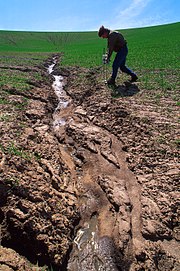Human-induced erosion as powerful as glaciers
Soil erosion has always been a big problem for ecosystems, and often increases with decreased ecosystem health, such as the dry conditions often encouraged by climate change. We normally think of rivers and glaciers as the most powerful eroders, but a study out today in Nature Geoscience finds that agriculture can erode the landscape at rates comparable to glaciers and rivers.
Michele Koppes of the University of British Columbia, the lead author on the study, says that their initial goal was to test the accepted scientific hypothesis that rivers are slower eroders than glaciers. But when they compiled data on erosion rates worldwide, they also found that farms play a much bigger role than previously thought. Koppes said in a press release:
This study shows that humans are playing a significant role in speeding erosion in low lying areas. These low-altitude areas do not have the same rate of tectonic uplift, so the land is being denuded at an unsustainable rate.
As for their original goal, they also present evidence that rivers can erode at rates of more than 1 cm per year, which is on par with averages for glaciers.
Read more at Nature Geoscience (subscription required for full article).
Koppes, M., & Montgomery, D. (2009). The relative efficacy of fluvial and glacial erosion over modern to orogenic timescales Nature Geoscience, 2 (9), 644-647 DOI: 10.1038/ngeo616
